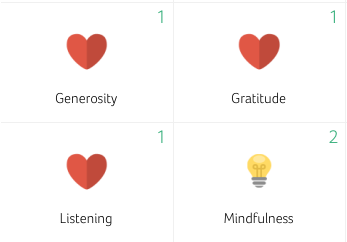Acknowledge Mindfulness with Bloomz
by Jude Miqueli, on Dec 20, 2017 9:35:02 AM
Students around the world are practicing mindfulness to develop and strengthen emotional health. In my class we start with a couple minutes of breathing. Students sit in silence for two minutes and notice sensations in their bodies. Students often report feeling calm after this exercise. During the month of November we focused on gratitude by imagining three big things and three little things we were grateful for. It only took a minute to focus on gratitude yet it revitalized our senses and made us feel happy. This exercise is important because it reminds us that although we experience situations in our lives that are distressing, focusing on the good keeps us balanced.

When learning how to be mindful students should discuss the scientific reasoning behind emotional reactions. This helps students navigate and regain control over big feelings. To put it in elementary terms we say that the prefrontal cortex is the computer and the amygdala is the feelings center. We can be mindful of our feelings without judging ourselves for them or making a decision about them. Anger doesn't have to be bad and happiness doesn't have to be good. When students are mindful of their emotions without succumbing to them, they are more equipped to take academic risks and try challenging new work.
Sometimes students have strong emotions that feel bad and end with yelling, hitting, or breaking things. Mindful students learn to create space between the emotion and the reaction. Sometimes just labeling the emotion can give enough space to start feeling better. Making a decision about how to respond comes next. Deep breathing helps students feel calm and move through anger.
Parents are supportive and appreciative for the practice of mindfulness in my classroom. Ever since I started acknowledging mindful behaviors on Bloomz parents have been commenting positively. I have also learned a great deal about what my students are experiencing on a physical and emotional level. This is a critical piece to reaching them academically.
For more information about mindfulness check out the National Education Association's "Adding Mindfulness to Student Toolboxes". Challenge your students to practice gratitude, deep breathing, listening, generosity, and mindfulness. Add these practices to your behavior award system on Bloomz parent teacher app to facilitate emotional intelligence in your classroom. Please share your experiences with mindfulness in your classroom in the comment section below.



